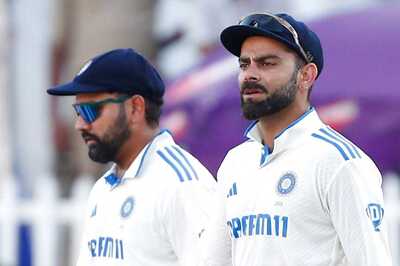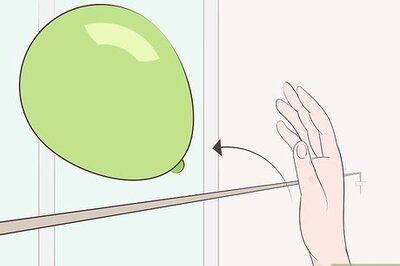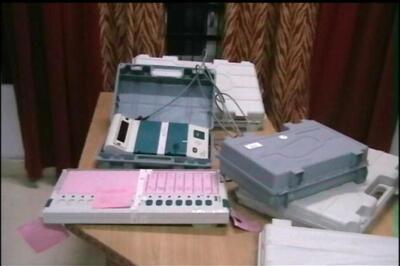
views
Are two dollar bills valuable?
Some uncirculated $2 bills are very valuable. A few examples of $2 bills have sold for tens of thousands of dollars, and one sold for nearly $100,000. But those were uncirculated bills, meaning they were never released to the public and were preserved in pristine condition. Most circulated $2 bills are worth face value ($2), although some may be worth a little more depending on their condition and rarity.
Most Valuable Two Dollar Bills
1862 U.S. Note The United States began producing $2 U.S. notes in 1862. They featured Alexander Hamilton—one of the Founding Fathers and the first Secretary of the Treasury. How much is it worth? A circulated 1862 $2 bill graded Fine or Extra Fine can be worth between $500 and $1,000. Uncirculated, it could be worth up to $2,800.
1869 U.S. Note In 1869, the $2 bill was redesigned to feature Thomas Jefferson. The notes from this year are also fairly collectible, especially in pristine condition. How much is it worth? Circulated, an 1869 $2 U.S. note with a red seal is worth between $500 and $1200. Uncirculated, it could be worth $3,800 or more.
1875 Lazy Deuce In 1875, the $2 bill featured a sprawling number “2” turned horizontally on its side. This design led to the nickname “Lazy Deuce,” and some examples in good condition can be fairly valuable. How much is it worth? Circulated $2 bills from 1875 can be worth $300–$1,100. Uncirculated, they can go for up to $2,300.
1880 with a brown or red seal and blue serial numbers There are several different varieties of the 1880 $2 bill, including the signatures on the front of the bill and the color combination of the seals and serial numbers. The rarest combination has the signatures “Rosecrans” and “Huston,” with a large brown seal and blue serial numbers. How much is it worth? An 1880 $2 bill with a brown seal and a blue serial number can be worth $600–$2,200 if it’s circulated and $3,500 or more uncirculated. Other variations may be worth $125–$350 circulated and $500 or more uncirculated.
1886 Silver Certificate In 1886, the Federal Reserve issued a $2 silver certificate that featured Winfield Scott Hancock, a Commanding General in the Army. There aren’t many examples surviving today, so these are considered highly collectible. How much is it worth? Circulated, an 1886 $2 Silver Certificate is worth between $350 and $900, depending on condition. Uncirculated, it can be worth $1,300 or more if it has a red seal and $1,400 or more if it has a brown seal. $2 Silver Certificates made between 1891 and 1899 are also considered highly collectible, ranging from $75 to $300 for a circulated bill and $475 to $2,100 or more for an uncirculated example.
1890 Treasury Note The 1890 $2 Treasury Note is one of the most valuable in the $2 bill series. Beginning in 1890, the Treasury was required to purchase a certain amount of silver every month. These notes were issued to pay for the silver. How much is it worth? 1890 $2 Treasury Notes are worth about $550–$2,500 if they’ve been circulated. Uncirculated, they’re worth $4,500 or more. $2 Treasury Notes from 1891 are also collectible, although they’re not as valuable as the 1890 series. A circulated 1891 $2 Treasury Note can be worth from $200 to $750, or $1,400 in uncirculated condition.
1928 U.S. Note 1928 was the first year that $2 bills were printed in their current size, which was smaller than in previous years. Starting in 1928, the bills featured Thomas Jefferson’s home, Monticello, on the back. 1928 was also one of only 3 years that the current-sized bills were printed with a red seal. These bills can be hard to find in good condition, so uncirculated examples in pristine condition can be especially valuable. How much is it worth? The value of these depends heavily on the condition and the letter after the serial number (known as the series). Uncirculated examples from the B series can be worth up to $1,000 or more, while a circulated bill from a more common series like D, F, or G might only be worth $4 or $5.
1953 or 1963 Red Seal In addition to 1928, these are the only other years that feature a red seal on the $2 U.S. Note in its current size. That makes them fairly collectible—but because they were printed in large numbers, they’re also pretty easy to find, so their value is moderate. You’ll only get top dollar for an uncirculated bill in excellent condition, especially one with a unique serial number, error, or other unique characteristic. How much is it worth? A circulated $2 bill from 1953 or 1963 is worth between $2.25 and $6.50
1976 Bicentennial The Federal Reserve stopped printing $2 bills in 1966, but they reintroduced the bills in 1976 in honor of the United States Bicentennial. The bills featured a newly-redesigned reverse, featuring a portrait of the signing of the Declaration of Independence. How much is it worth? A circulated $2 bill from 1976 is worth about $2.50, and an uncirculated example is worth about $4.50. However, the value may be higher if they feature a special Bicentennial cancellation stamp, low serial number, error, or other unique characteristic.
1995 BEP Sets In 1995, the Bureau of Engraving and Printing (BEP) created limited edition star note sets. These bills were intended to be saved as collectibles—they came in a green Millennium Note folder and have a serial number that starts with “2000.” How much is it worth? A single good example of this bill can be worth $40 or more. If you have the set of all 12 district notes, it could be worth at least $500.
2003 BEP set In 2003, the BEP offered a special limited-edition $2 bill in sets of 12, one for each district. The notes all have the same serial number and feature a star, and they were intended to be collectible items. How much is it worth? If you have the whole set of 12, they could be worth $900 or more.
Factors that Impact the Value of $2 Bill
Year and Series Older bills and series with limited runs are more valuable to collectors because they’re harder to find. If you have a $2 bill from before 1899, for example, it’s probably worth at least $100 even in circulated condition. If multiple versions of a bill were printed in a single year—like if a certain run featured a different seal or signature—the rarest series from that year will be more valuable than the most common.
Serial number Collectors prize bills with very low serial numbers. So if you have a $2 bill with a serial number that says 00000001 or 00000002, you could probably sell it for more than face value, even if it’s a common year. Unique serial numbers can make a bill collectible, too. For instance, if your serial number says something like 22224444 (known as a quad double in the trade) or 23456789 (an ascending ladder), you might find a collector who would pay more for it.
Condition The condition of a bill can have a huge impact on its value. A pristine bill with crisp edges and corners and no fading or folds would be worth significantly more than a bill that’s wrinkled, folded, faded, or torn. How well the image is centered on the bill can also impact the value. Even a single fold can affect the value of your bill, so if you have a $2 bill that you think might be collectible, store it flat in an envelope or currency book.
Unique features If there’s anything that sets your bill apart from other $2 bills, even within the same year, it will probably be more valuable than one that’s a standard design. Examples of unique features on a $2 bill include: Seal: Bills with a red seal are the hardest to find, then blue, then brown. Green seals are used today, and they’re the most common. Star notes: If a run of bills has to be reprinted, the reprints will feature a star by the serial number. Not many star notes are produced in a run, so these tend to be collectible. Errors: If your bill has a printing error, smudged ink, or another error, it could be more valuable.
How do I know if my $2 bill is valuable?
Check the year, seal color, and serial number to see if your bill is rare. Older and rare bills will be worth more than more current bills. Also, pay attention to the condition—a torn, creased, or faded bill might not be worth much more than face value. If you’re not sure, you can also look up the value using a price guide.
How do you sell $2 bills?
Sell online, at a trade show, or at a banknote shop. Before you try to sell your $2, do a lot of research on its value. Look at online listings of similar bills, and see what they're selling for (not just the listing price) to get an idea of what yours is worth. If it's not already graded, consider having it professionally evaluated—especially if you think it's very valuable. Once you have a price in mind, you can sell your $2 bill online through eBay or another auction site. You can also check for trade shows near you where banknote dealers trade bills and bring your bill there, or reach out to a local banknote dealer. For very valuable bills, consider reaching out to a well-known auction house.
Uncirculated vs. Circulated Bills
Uncirculated bills have never been used to buy or sell goods. They've been preserved as a collectible since they were printed, often in bill books or special sleeves. Compared to circulated bills, uncirculated bills will typically have crisp edges, sharp corners, and vivid details, especially if they are well-preserved. Circulated bills have been used in regular transactions, like shopping or paying for services. They usually have signs of wear, like fading, creases, or other marks. Some collectors prefer circulated bills, but generally, their value is less than that of an uncirculated bill.
What's the market for rare $2 bills?
Uncirculated $2 bills can be highly collectible. Notaphily, or the hobby of collecting paper currency, has grown in recent years, largely thanks to the increase in information and availability due to the internet. More people in the hobby means the market is strong. There's no guarantee what the value of $2 bills will be in the future, but if you find one in good condition, there's a good chance that you'll be able to find someone who needs it to complete their collection.
FAQs
Are two dollar bills rare? $2 bills are uncommon, but they’re not rare. According to the Federal Reserve, there were $3.2 million worth of $2 bills in circulation in 2023.
Are $2 bills still being printed? Yes, but they’re not printed every year. Because people don’t use $2 bills in everyday transactions, the demand for them is fairly low. As a result, the Treasury usually only prints $2 bills every 2–4 years, instead of every year like more common bills.
Why are people superstitious about $2 bills? In the past, $2 bills were associated with bribery and gambling. There was an urban legend that politicians would buy votes for $2, so someone who used a $2 bill might be judged for selling their vote. $2 bills were also frequently used in gambling. “Deuce” was a nickname for the devil, so some people thought the bills brought bad luck.
When did they stop making $2 bills? Low demand for $2 bills prompted the Federal Reserve to stop printing them in 1966. But they were reintroduced in 1976 in honor of the nation’s Bicentennial, and they’re still in circulation today.
Why are $2 bills called “Toms”? Since 1869, $2 bills have featured Thomas Jefferson on the face. Over time, the bills picked up the nickname after him.




















Comments
0 comment